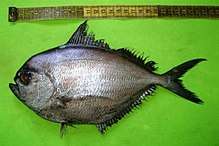Brama dussumieri
Brama dussumieri is a species of Brama in the family Bramidae. It can be distinguished from congeners through the following characteristics:
- Possessing pectoral fins that are placed low on the body in both juvenile 'and’ adult stages (overlap with Brama caribbea, Brama myseri, and Brama orcini).
- Having relatively long ventral fins
- Having a total number of vertebrae equaling 40 or more (overlaps with Brama myersi)
- Possessing a total number of anal fin rays equaling 28 or fewer[1]
| Lesser bream | |
|---|---|
 | |
| Scientific classification | |
| Kingdom: | Animalia |
| Phylum: | Chordata |
| Class: | Actinopterygii |
| Order: | Perciformes |
| Family: | Bramidae |
| Genus: | Brama |
| Species: | B. dussumieri |
| Binomial name | |
| Brama dussumieri (Cuvier, 1831) | |
Ecology
Many bramids serve as important forage fish for large, pelagic, predatory fishes. B. dussumieri have been successfully collected from the stomachs of bigeye and yellowfin tuna and striped marlin, suggesting that they serve a similar role for fast swimming, open ocean predators.[2][3]
Distribution
Brama dussumieri can be found throughout the high seas of all tropical oceans (e.g. Atlantic, Pacific, Indo-Pacific)[1][4] and associated seas, such as the Yellow and Sea of Japan off the coast of Korea[5].
Reproduction
Brama dussumieri specimens have been collected at various life stages, including larval and juvenile, globally, suggesting that there is no specific localized spawning area. [1] Juveniles have been collected throughout the Gulf of Mexico, Caribbean, eastern Atlantic, Gulf Stream of Chesapeake Bay, and the Indo-Pacific at various times through the year. In some locations (i.e., the Indo-Pacific), young can be collected nearly every month of the year.[1][6]
Females are thought to reach sexual maturity by 170mm standard length. Egg diameter ranges from 0.3mm - 1.6mm, depending on the gonosomatic index (GSI), with larger eggs being present in females with a high GSI.[6]
Genome
The complete mitochondrial genome of B. dussumieri was sequenced in 2018 and found to be a characteristic the typical Brama mitochondrial genome. The genome contains 26.21% adenine, 25.65% thymine, 16.83% guanine, and 31.31% cytosine, appearing nearly identical to that of Brama japonica, a congener.[7]
References
- G. W. Mead (1972). "Bramidae". Dana Report. 81: 1–166.
- W. Pelczarski (1988). "Examination of food of yellowfin tuna (Thunnus albacares) and bigeye tuna (T. obesus) from the open waters of the central Atlantic". Col. Vol. Sci. Pap. ICCAT. 28: 58–73.
- M. Moteki; M. Arai; K. Tsuchiya; H. Okamoto (2001). "Composition of piscine prey in the diet of large pelagic fish in the eastern tropical Pacific Ocean". Fisheries Science. 67: 1063–1074.
- J de la Cruz-Agüero; R. Moncayo-Estrada; V.M. Cota-Gómez; H. Villalobos-Ortiz; A. Valdez-Pelayo (2016). "Unusual records of deepwater teleosteans trawled off the western coast of Mexico". Journal of Fish Biology. 89: 1889–1896.
- W.J. Lee; J.K. Kim (2015). "New record of Brama dussumieri (Pisces:Bramidae) from Korea, as revealed by morphological and molecular analyses". Fisheries and Aquatic Sciences. 18 (3): 311–316.
- M. Omori; H. Takechi; T. Nakabo (1997). "Some notes on the maturation and spawning of the bramid fish, Brama dussumieri, in the southeastern waters of Japan". Ichthyological Research. 44 (1): 73–76.
- L. Xu; X. Wang; H. Li; F. Du (2018). "The complete mitochondrial genome of Perciformes fish (Brama dussumieri) from South China Sea". Mitochondrial DNA Part B. 3 (2). doi:10.1080/23802359.2018.1501293.